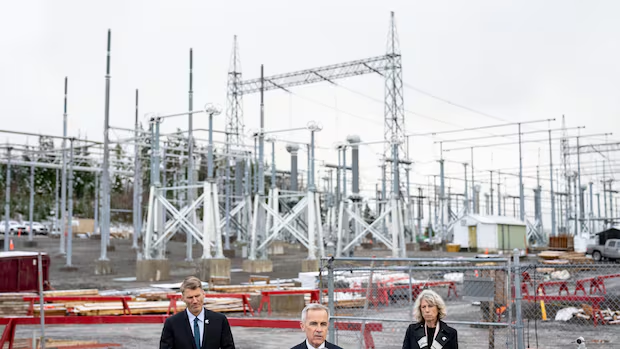
Prime Minister Mark Carney announced this week a second round of projects he’s recommending get fast-tracked by his government’s Major Projects Office (MPO) as part of his promise to reduce Canada’s economic reliance on the United States.
Thursday’s announcement saw multibillion-dollar energy and natural resources proposals brought to the top of the pile, but there are still questions about what a referral to the MPO actually means.
Part of the confusion lies in the government’s choice of language. So far, Carney has referred projects to the MPO that he’s deemed of “national importance” or “national significance.”
None of the projects — at least not yet — have been slapped with the “national interest” label, a new (and controversial) designation that would essentially allow the federal cabinet to sidestep certain laws to ram a project forward in the name of spurring economic growth on home soil.
Many of the projects heading to the MPO for approval are also well into development, raising the question: So what’s the point, and what happens now?
With the agency still in its infancy, there’s still a big question mark hanging over whether the Major Project Office process — one of Carney’s signature policy proposals — will work.
Even Carney himself cautioned that referring a project to the MPO “does not mean the project is approved.”
“It means that all the efforts are being put in place from the federal government in order to create the conditions, so it could move forward,” he said Thursday. “But those decisions are taken by many parties, including very much First Nations.”
WATCH | At Issue | Can Mark Carney make Canada an energy superpower?:
At Issue | Can Carney make Canada an energy superpower?
At Issue this week: Prime Minister Mark Carney unveils the next round of nation-building projects he says will transform Canada’s economy. Conservative Leader Pierre Poilievre tries to move past party struggles. And François Legault’s fight with Quebec doctors.
With U.S. President Donald Trump’s tariffs causing trading uncertainty, the MPO has been pitched as a clearing house to get projects built faster in Canada.
According to the Major Project Office, once it receives a proposal, it works with proponents, provinces and territories, and Indigenous people to find the “right way forward.”
That could include focusing on streamlining permitting processes, addressing regulatory challenges, structuring financing and trying to reduce risks for projects.
Projects completed ‘on time and on budget’
Asked for clarity on Thursday, Dawn Farrell, the MPO’s president and CEO, said her office will shepherd the projects across the finish line “on time and on budget.”
“There’s a lot of work as you get to the end of the line and you need to pull things over,” she said.
Farrell pointed to the recently announced Crawford nickel project in Timmins, Ont., as an example. Canada Nickel Company proposes to build a mine capable of producing 240,000 tonnes of ore per day.
She said her office will work with the company to get its permitting down “in parallel” and not “sequentially.”
“So something that might have taken five or six more years can now take two years,” Farrell, the former head of Trans Mountain Corp., said.
Farrell’s office could review a proposal and determine whether it would benefit from the ‘national interest’ designation under Bill C-5’s fast-tracking provisions. (Ethan Cairns/The Canadian Press)
The MPO is also working with proponents and the Canada Infrastructure Bank and the Canada Growth Fund, two of the federal government’s project-financing vectors, to create certainty in financing.
For example, it was announced on Thursday that the Canada Infrastructure Bank will loan B.C. Hydro’s North Coast Transmission Line proposal some $139 million to help get the project built.
“And then the tough stuff is to ensure that when they get into the construction component of it, that we work with our labour group to make sure there’s availability of labour,” Farrell said.
“That the way that the permitting happens during construction works in a very slick and efficient way so that we can do the construction and build the projects in the time frame that they should be built in without cutting corners.”
Chosen projects can sidestep usual legal rules
Farrell’s office could also review a proposal and determine whether it would benefit from the “national interest” designation under Bill C-5’s fast-tracking provisions.
The Building Canada Act essentially gives cabinet the power to allow chosen projects to sidestep the normal legal requirements — including the Fisheries Act, the Species At Risk Act and the Impact Assessment Act — in the name of the national interest.
Canada Nickel CEO Mark Selby said on Thursday that referring his mine to the MPO “puts us in the fast lane” even without the special national interest label.
“We probably won’t be designated, we’ll be just referred, and work through the permitting process, but it should put us at the front of the line to work through specific permits and issues that may come up,” he said.
The bill flew through Parliament in the spring before receiving royal assent in June, garnering backlash from the opposition parties and Indigenous communities about giving government decision-making power when it comes to natural resource projects.
Some environmental critics suggested the powers granted to cabinet were undemocratic and “undermine constitutional principles.”
Carney adding bureaucracy: Poilievre
Not everyone is convinced the MPO will work.
Conservative Leader Pierre Poilievre said Canada’s permitting process remains “uncompetitive” and argued Carney’s stated commitment to fast-track development won’t untangle the red tape.
“Mark Carney’s solution? Add another bureaucracy. He’s created yet another bureaucracy, a new bureaucratic hurdle for miners and oil and gas enterprises and other resource companies to jump through in order to get anything approved,” Poilievre told reporters in Kelowna, B.C., on Thursday.
“And yet again, today, instead of getting things done, Mark Carney was standing up doing photo ops announcing that he’s going to approve a bunch of projects that were already going to happen.”
Here are the six latest projects and one concept being referred to the MPO:
They follow the first five projects Carney recommended in September. They include:
Phase 2 of LNG Canada in Kitimat, B.C., doubling its production of liquefied natural gas.The Darlington New Nuclear Project in Clarington, Ont., which will make small modular reactors.The Contrecoeur Terminal container project to expand the Port of Montreal.The McIlvenna Bay Foran copper mine project in Saskatchewan. The expansion of the Red Chris Mine in northwestern B.C.
There’s also another category of proposals, deemed “transformative” projects, that require further development before approval. So far that list includes an upgrade to the Port of Churchill and high-speed rail between Toronto and Quebec City.
The seven initiatives announced Thursday, combined with the five Carney recommended for approval in September, are worth a combined $116 billion to the economy, according to government figures.





